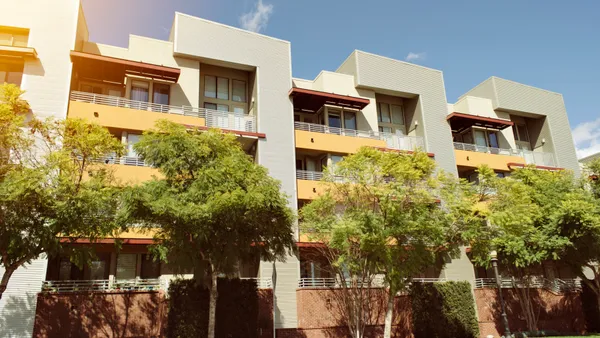Dive Brief:
- Starts for buildings with five or more units came in at a seasonally adjusted rate of 460,000 in July, nudging up only 0.4% from a year earlier, according to the most recent starts data report from the U.S. Department of Housing and Urban Development and the U.S. Census Bureau.
- The July building permit numbers slightly outpaced starts numbers for buildings with five or more units, coming in at a seasonally adjusted rate of 464,000 in July, a 32% year-over-year decline. Developers completed 297,000 apartments in the month, 23% less than a year earlier.
- Overall housing starts rose 5.9% YOY to 1.5 million. Permits fell 13% to 1.4 million, while completions dropped 5.4% to 1.3 million.
Dive Insight:
Despite July’s starts numbers staying flat, apartment executives have seen a dropoff in appetite for new, large projects, which showed up in July’s starts numbers. The culprit is higher interest rates, which have increased borrowing costs for developers.
“We continue to expect the rate of multifamily starts to slow throughout the year as national rent growth is sluggish and banks tighten lending conditions,” said Mark Palim, deputy chief economist at Fannie Mae, in a press statement.
Even well-funded REITs are cutting back. Arlington, Virginia-based AvalonBay Communities’ Chief Investment Officer Matt Birenbaum said the firm was reducing guidance for the number of projects it is starting in 2023.
“We have raised our required returns on new development starts given our increased cost to capital and focus on maintaining 100 to 150 basis points of spread between underlying market cap rates and our projected development,” Birenbaum said on the company’s most recent earnings call.
Construction costs aren’t falling
Even with those declines, developers aren’t seeing tangible price savings yet.
“There’s not a lot of motivated land sellers, and a 30% decline in land costs with a construction cost that has stayed flat but not gone up still is very, very hard to pencil,” said Houston-based Camden Property Trust CEO Ric Campo on the company’s second-quarter earnings call.
A lot of contractors are still building out projects. Once those jobs are finished, those firms may be looking for jobs and willing to negotiate on price.
“When contractors start looking out into the future and they don’t see a pipeline, they’re going to have to be more competitive and start tightening their margins and thinking about how they have to compete to get the next job in 2025 or 2026,” Campo said. “So we could see some cost reductions next year toward the end of the year. But the pipeline is full right now, and contractors are still printing money.”
Click here to sign up to receive multifamily and apartment news like this article in your inbox every weekday.











